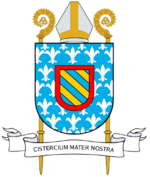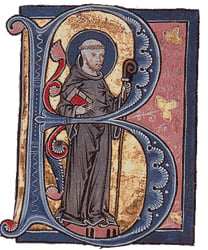Ailred of Rievaulx
| Saint Ailred of Rievaulx | |
|---|---|
| Abbot | |
| Born | 1110 in Hexham, Northumberland |
| Died | 12 January 1167 in Rievaulx, North Riding of Yorkshire |
| Venerated in | Roman Catholic Church; Anglican Communion |
| Canonized | 1476
by the Cistercians (promulgated) |
| Major shrine | Rievaulx Abbey, North Riding of Yorkshire (destroyed) |
| Feast | 12 January |
| Attributes | Abbot holding a book |
| Patronage | bladder stone sufferers |
Ailred or Ælred or Ailred of Rievaulx, Abbot of Rievaulx (b. Hexham 1110; d. Rievaulx 12 January 1167), is a Christian saint and historian best know for his exhortations toward chastity and purity. The medieval church was itself compromised by the conduct of some of its clergy, including bishops, whose sexual morality broke the rule of celibacy and caused embarrasment when the Church admonished laity to practice chastity. A church that was itself wealthy, too, often neglected spiritual concerns and acted as a wordly power. Bishops and abbots were effectively feudal lords, and some were more interested in power than in religion. Among these, Ailred of Rievaulx shines like a lone star in the night-sky. His approach to matters of sexuality was compassionate in as much as he knew that people are not perfect but he distinguished willful, repeated transgression and immorality from genuine lapses caused by sin. His genuine interest in spititual wholeness, and his advice to the king to act justly, were exactly what ought to concern a Church leader. Sadly, that king, Henry II of England could not avoid clashing with his Archbishop and former Chancellor, Thomas Becket over who has jurisdiction when a priest was involved in legal proceedings, which led to the Archbishop's murder.
Early Life
Ailred was an Anglo-Saxon, born in Hexham, Northumbria, in 1110. His father, a married priest, sent him to spend several years at the court of King David I of Scotland. Ailred rose to be Master of the Household before leaving the court to enter a Cistercian monastery at Rievaulx Abbey, in Yorkshire, around the year 1134.
Cistercians

The Order of Cistercians is sometimes called the White Monks (from the colour of the habit, over which a black scapular or apron is sometimes worn) is a Roman Catholic religious order of cloistered monks. The first Cistercian abbey was founded by Robert of Molesme in 1098, at Cîteaux Abbey. Two others, Saint Alberic of Citeaux and Saint Stephen Harding, are considered co-founders of the order, and Bernard of Clairvaux is associated with the fast spread of the order during the 12th century.
The cornerstone of Cistercian life was a return to a literal observance of the Rule of St Benedict, rejecting the developments the Benedictines had undergone, and tried to reproduce the life exactly as it had been in Saint Benedict's time. however on various points the Cistercians went beyond it in austerity. The most striking feature in the reform was the return to manual labor, and especially to field-work, which became a special characteristic of Cistercian life. The Cistercians became the main force of technological diffusion in medieval Europe.
Spread of the Cistercian order
By 1111 the ranks of the order had had grown sufficiently at Cîteaux and Stephen Harding sent a group of 12 monks to start a new community dedicated to the same ideals of the strict observance of Saint Benedict. It was built in Chalon sur Saône in La Ferté on May 13, 1113.[1] Bernard of Clairvaux arrived at Cîteaux during 1113 with 30 other monks to join the monastery. The nextg year another daughter house was founded, Pontigny Abbey. The next year, in 1115, Bernard founded Clairvaux, followed by Morimond in the same year. Then Preuilly, La Cour-Dieu, Bouras, Cadouin and Fontenay. At Stephen Harding's death (1134) there were more than 30 Cistercian daughter houses. When Bernard passed away (1154) there were more than 280. By the twelfth century there were more than 500 daughter houses. Meanwhile, the Cistercian influence in the Roman Catholic Church more than kept pace with this material expansion, so that St Bernard saw one of his monks ascend the papal chair as Pope Eugene III.
Religious life
Ailred became the abbot of a new house of his order at Revesby in Lincolnshire, and later, abbot of Rievaulx itself in 1147. He would spend the remainder of his life in the monastery. Under his administration the size of the abbey grew to some six hundred monks. He also made annual visits to several other Cistercian houses in England and Scotland, with other visits to places as far as Citeaux and Clairvaux. Alred was also seperior of all the Cistercians in England, as well as abbot of Revesby. These frequent travels and visits may have compromised his health, for he is recorded as suffering from a very painful, unspecified disease in his later years.
Ailred died on January 12, 1167, at Rievaulx. He is listed for January 12 in the Roman Martyrology and the calendars of various other churches.
Writings
He wrote several influential books on spirituality, among them The Mirror of Charity perhaps at the request of Bernard of Clairvaux and Spiritual Friendship. He also wrote seven works of history, addressing two of them to Henry II of England, advising him how to be a good king and declaring him to be the true descendant of Anglo-Saxon kings. He was also a friend of King David of Scotland and Stephen of England, Henry's cousin and predecessor. Until the twentieth century Ailred was generally known as a historian rather than a spiritual writer. For many centuries his most famous work was his Life of Saint Edward, King and Confessor.
His public works encouraged virginity among the unmarried and chastity (not abstinence) in marriage and widowhood, and warn against any sexual activity outside of marriage. In all his works he treats same-sex and opposite-sex attraction as equally possible and equally dangerous to one's oath to celibacy. At the same time, he expressed compassion about human failings, criticized the absence of pastoral care for the Nun of Watton and her case of pregnancy while within a Gilbertine convent. It is believed by some that he expressed complacency toward monks walking hand in hand inside the monastery.
Most of Ailred's works have appeared in translation from Cistercian Publications. They include:
- Mirror of Charity
- Spiritual Friendship
- Rule of Life for a Recluse
- Jesus as a Boy of Twelve
- Pastoral Prayer
- On the Soul
- Genealogy of the Kings of the English
- Battle of the Standard
- Lament for the Death of King David of Scotland
- The Life of Saint Edward, King and Confessor,
Cistercian Publications have also brought twenty of Ailred's known sermons to the public eye. Other historical works (Life of Saint Ninian, On the Saints of Hexham, and A Certain Wonderful Miracle) appeared in 2006.
Legacy
For his efforts in writing and administration he has been called the "St. Bernard of the north." He has also been described by David Knowles, a historian of monasticism in England, as "a singularly attractive figure... No other English monk of the twelfth century so lingers in the memory.[2]
Ailred has been adopted as the patron saint of Integrity, an organization in the Episcopal Church in the United States of America composed of gays and lesbians and their friends; and of the Order of St. Ailred, in the Philippines. He is also patron saint of The National Anglican Catholic Church, a gay-friendly church serving New England and the northeast United States.
There is a high school named after St. Ailred in Newton-le-Willows, Lancashire in the United Kingdom.
Notes
- ↑ Tobin, pp. 46.
- ↑ Attwater, Donald, and Catherine Rachel John. The Penguin dictionary of saints. Penguin reference books. Harmondsworth: Penguin 1983. ISBN 9780140511239
ReferencesISBN links support NWE through referral fees
- Dutton, Marsha, et al. Truth As Gift Studies in Medieval Cistercian History in Honor of John R. Sommerfeldt. Cistercian studies series, 204. Kalamazoo, Mich: Cistercian Publications, 2004. ISBN 9780879073046
- Sommerfeldt, John R. Aelred of Rievaulx on Love and Order in the World and the Church. The Newman Press significant scholarly studies. New York: Newman Press, 2006. ISBN 9780809143238
- Squire, Aelred. Historical Factors in the Formation of Aelred of Rievaulx. Collectanea Ord. Cist. Ref. [Offprint]. Westmalle: Collectanea Ord. Cist. Ref, 1960. OCLC 56196014
- Squire, Aelred. Aelred of Rievaulx A Study. Cistercian studies series, no. 50. Kalamazoo, Mich: Cistercian Publications, 1981. ISBN 9780281038510
External Links
- Ailred of Rievaulx Retrieved October 20, 2007.
Credits
New World Encyclopedia writers and editors rewrote and completed the Wikipedia article in accordance with New World Encyclopedia standards. This article abides by terms of the Creative Commons CC-by-sa 3.0 License (CC-by-sa), which may be used and disseminated with proper attribution. Credit is due under the terms of this license that can reference both the New World Encyclopedia contributors and the selfless volunteer contributors of the Wikimedia Foundation. To cite this article click here for a list of acceptable citing formats.The history of earlier contributions by wikipedians is accessible to researchers here:
The history of this article since it was imported to New World Encyclopedia:
Note: Some restrictions may apply to use of individual images which are separately licensed.
